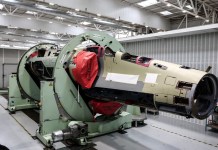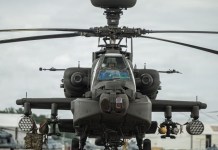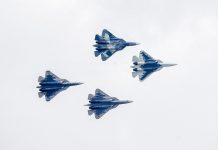A full-scale India-China war looks unlikely however the last time India and China engaged in a conventional war was in 1962 over the same Himalayan region where at least 20 Indian soldiers were killed recently, writes the CNN.
How Many Chinese Soldiers Were Killed In The India-China Clash At Galwan Valley / Ladakh?
Nuclear weapons: India vs China
Indian Air Force Deploys Su-30 MKI, Apache Helicopters In Forward Bases In Ladakh
No one expects the fresh clashes to explode into nuclear war, but the fact that both China and India have become nuclear powers since their previous conflict cannot be overlooked when evaluating the balance of power.
Data released by the (SIRPI) assess that China has roughly 320 nuclear warheads — more than double India’s 150. Both nations have seen their armouries grow in the past year, Beijing’s by 40 warheads and New Delhi’s by 10, according to SIRPI.
India-China Standoff: Why Is Indian Army Aggressive Against Pakistan But Silent On China?
Both nuclear-armed nations maintain a triad of delivery systems — missiles, bombers and submarines. Both nations have also vowed to a “no first use” policy, however, meaning they’ve pledged only to use nuclear arms in retaliation to a nuclear attack on their county.
India-China War: Air forces
India has about 270 fighters and 68 ground-attack aircraft which New Delhi can use to counter China according to a study published in March by the Belfer Center. India also maintains a series of small air bases near the Chinese border from which it can stage and supply those aircraft, the Belfer study claimed.
China, by contrast, has 157 fighters and a small fleet of ground-attack drones in the region. The PLAAF uses eight bases in the region, but most of those are civilian airfields at challenging altitudes, the study suggests.
After Killing 20 Indian Soldiers, China Wants Delhi To Punish Indian Border Troops
“The high altitude of Chinese air bases in Tibet and Xinjiang, plus the generally difficult geographic and weather conditions of the region, means that Chinese fighters are limited to carrying around half their design payload and fuel,” the study claims.
Aerial refuelling could give the Chinese planes additional payload and combat time, but the PLAAF doesn’t have adequate aerial tankers for the job. The Belfor study also gives the Indian Air Force (IAF), with its Mirage 2000 and Sukhoi Su-30 jets, a qualitative edge in the region, where China fields J-10, J-11 and Su-27 fighters.
Australian Media Says India Has The ‘Most Powerful Weapon’ Ready Against China
Meanwhile, India has developed these bases in the region with China in mind, according to an October 2019 report from the Center for a New American Security. “To weather a potential People’s Liberation Army (PLA) attack, India has placed greater emphasis on infrastructure hardening; base resiliency; redundant command, control, and communications systems; and improved air defence,” the report claims.
The Belfer study indicated that China, facing perceived intimidations from the US on its eastern and southern flanks, has boosted its bases there and neglected near the Indian border, leaving at least four PLA airbases exposed.
“Indian destruction or incapacitation of some of the four above airbases would further increase these PLAAF operational inflexibilities and weaknesses,” it claims. The Belfer report gives the edge to India’s air force in one other area — experience.
India-China Border Clash: India Has 2 Options – Accept Losses or Counter China: US Experts
“Recent conflicts with Pakistan give the current IAF a level of institutional experience in actual networked combat,” it says. Lacking such experience, Chinese pilots may have difficulty thinking for themselves in a dynamic aerial battlefield, according to the Belfer report.
India-China War: Ground forces
While India has the experience in the air, the CNAS report says it is also extremely well trained on the ground, battling in places like Kashmir and in encounters along its border with Pakistan.
“India is by far the more experienced and battle-hardened side, having fought a series of limited and low-intensity conflicts in its recent past,” the CNAS report says. “The PLA, on the other hand, has not experienced the crucible of combat since its conflict with Vietnam in 1979.”
That month-long border war, driven by China in reaction to Vietnam’s military intercession in Cambodia, is largely considered a defeat for China. The PLA had difficulty making gains against Vietnamese troops that were smaller in number but immensely more trained after battling US forces during the Vietnam War.
JF-17 vs Rafale: Why Pakistani JF-17 Thunder Poses A Serious Threat To Indian Rafale Fighter Jets?
Belfer estimates there are about 225,000 Indian ground forces in the region, as well as 200,000 to 230,000 Chinese. The figures may be confusing. Counted among those PLA forces are units assigned to keep down any chance of rebellion in Xinjiang or Tibet, or deal with any possible friction along China’s border with Russia.
Moving them to the Indian front in the event of large-scale clashes presents a logistical dilemma, as Indian airstrikes could target high-speed rail lines on the Tibetan plateau or chokepoints in the rugged terrain near the border. “By contrast, Indian troops are already largely in position,” the report says.
China’s Attack On Indian Army In Ladakh – India Failed To Modernize, Stay Competitive – NYT
The CNAS report adds that those Indian troops operate in rough terrain in steep valleys and can’t be easily deployed to counter transgressions that any Chinese aggression might make. In short, the Indian troops too could be vulnerable to Chinese artillery and missile attacks on choke points in the mountains.
Those attacks could come by Chinese artillery or missiles placed on the Tibetan plateau, which in some cases look right down on Indian border posts, the CNAS report says. But the issue is whether, in the event of large-scale battle, China has sufficient missiles to take out all the targets it would need to hit in India.
The Belfer study quotes the evaluations of a former Indian Air Force officer, who predicts that China would need 220 ballistic missiles to knock out one Indian airfield for a day. With only 1,000 to 1,200 missiles available for the task, China would quickly run out of missiles to shut down India’s airfields, it says.
Indian Air Force Deploys Su-30 MKI, Apache Helicopters In Forward Bases In Ladakh
One area where China may be having an edge is the technology and new weapons. With a larger defence budget and quickly modernizing defence forces, Beijing can’t be counted out to close any gaps in its forces.
“China’s economy is five times the size of India’s and Beijing’s defence budget far surpasses New Delhi’s defence budget by a factor of four to one,” said Nishank Motwani, an international adviser at the National Center for Dialogue and Progress in Afghanistan. “The power differential between China and India is in Beijing’s favour and this asymmetry is only widening.”
Chinese state media has recently been heavy on articles and videos of new weaponry being stationed to its Tibetan region for drills, including the Type 15 light tank and the new 155-millimetre vehicle-mounted howitzer. Both were introduced leat year in a military parade in Beijing.
“The weapons were specially designed with advantages for plateau regions and can play significant roles in safeguarding border areas,” military experts told the state-sponsored Global Times. The Chinese outlet on Tuesday — after the encounter with Indian troops the night before — mentioned the new weapons in a report on war games in the mountainous region.
India-China Border Tensions Still High Over Mutilated Bodies Of Indian Soldier – Reports
“These kinds of drills demonstrated the PLA’s capability to win a regional, high-elevation conflict in its early stages by decisively eradicating the hostile headquarters and commanders, a PLA veteran who was once deployed in Tibet and asked not to be named told the Global Times,” the report said.
India-China War: Allies
In a possible India-China war, China could be largely on its battle against India, New Delhi, on the other hand, has been developing defence ties with countries wary of Beijing as a rising military power. India has grown closer to the US military in recent years, with Washington calling India a “major defence partner” while increasing bi- and multilateral training.
In the event of an India-Chin war, US intelligence and surveillance could help New Delhi get a clearer picture of the battlefield. The Belfer report uses the example of what might happen if China was to surge troops from its interior to the front lines in the mountains.
How Special Forces Of India, MARCOS & Para SF Compete Against US Navy SEALs?
“Such a Chinese surge would also attract attention from the United States, which would alert India and enable it to counter-mobilize its own additional forces from its interior,” it says.
India participates in joint military exercises with countries like the US, Japan, France and Australia. “Western troops participating in such war games and exercises regularly have revealed a grudging admiration for their Indian counterparts’ tactical creativity and a high degree of adaptability,” the CNAS report says.
“China’s joint training endeavours, on the other hand, thus far have remained comparatively basic in scope — with the notable exception of its defence drills with Pakistan and Russia.”
Via CNN




